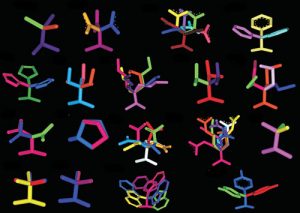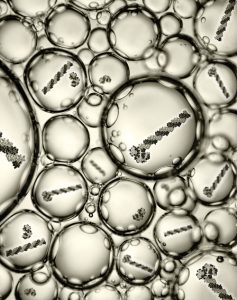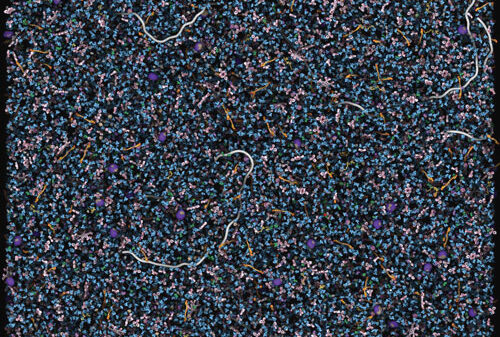The availability of an abundance of experimentally determined structures of proteins and protein-protein complexes is fueling research on protein interactions and complex formation.
Innovative approaches investigating these interactions at the molecular level are offering new insights into drug discovery and design.
Researchers are scheduled to present the cutting edge of their tools and technologies targeting protein-protein interactions (PPIs) at Select Biosciences’ upcoming “Discovery Chemistry Congress” meeting.
New tools and approaches aimed at visualization, interaction, and software development facilitate the understanding of the complex nature of protein interactions, especially in the context of cellular environments, according to Arthur Olson, Ph.D., professor at the Scripps Research Institute.
“The software takes the recipe of all the proteins in a cellular environment and uses that information to build a 3D physical model of that environment,” he explains. By modifying the ingredients in the external recipe, researchers can study specific interactions more readily, according to Dr. Olson.
The Molecular Graphics Laboratory under the direction of Dr. Olson has developed novel techniques for computation analysis and modeling of the interaction of protein-ligand, protein-protein, and other biomolecular systems. Understanding drug resistance in HIV is one of his goals.
Using high-end computer graphics such as those developed for gaming and animation in Hollywood, Dr. Olson’s team has designed molecular modeling software to visualize protein interactions. His work on the ongoing HIV project takes the virus and its interactions as a whole that cannot be known from their individual binary PPIs. In his view, “the ability to model crowded environments in cells and viruses is critical to develop tools for designing drugs.”
His lab at the Scripps Institute is engaged in developing tools to build a better model of the cellular environment so scientists and others can develop a realistic simulation of living systems. “As we continue to stabilize and make the algorithms deeper and broader to make them useful for research, we can apply them as useful tools for scientists to communicate with each other in publications, to teach, or for public outreach projects.”
Indeed, Dr. Olson and his team are credited with the development of AutoDock, a suite of automated docking tools, designed to predict how small molecules, such as substrates or drug candidates, bind to a receptor of known 3D structure. It is used by more than 29,000 researchers around the world, he says.
The protein-protein docking phenomenon is one of the key elements of activity in computational structural biology. Characterization of conformational properties of protein-protein interactions is essential to understanding the mechanisms of protein association, and insight into the conformations of the surface side chains is critical for modeling protein complexes.

According to Ilya Vakser, Ph.D., professor at the center for bioinformatics and department of molecular biosciences, University of Kansas, template-based modeling for protein-protein docking is facilitated by the increasing availability of co-crystallized protein-protein complexes. Structure alignment techniques are useful in the detection of remote target-template similarities. The size of the structure involved in the alignment is important for successful modeling.
Dr. Vakser’s research suggests that structural areas corresponding to the cut-off values of 12 Å were optimal in their interface alignment-based docking. He notes that the template-based docking by structural alignment represents the best choice for large-scale (e.g., on the scale of the entire genome) applications to protein interaction networks.
“The ability to modulate protein-protein interactions is important for curing diseases,” Dr. Vakser says. “Modeling of protein-protein complexes allows one to structurally characterize protein-protein interaction networks, including important pathways involved in diseases.” It facilitates the identification of new drug targets, as well as ensures adequate structural description of the existing ones.
On the implications of his methodology, Dr. Vakser says, “the procedures for conformational sampling of protein surface side chains can be applied to opening of binding pockets at protein-protein interfaces and assessment of their druggability, providing structural foundation for computer-aided drug design for modulation/inhibition of protein interactions.
“In the future, optimized sets of structural templates, as well as more powerful refinement and scoring approaches, should provide a much better coverage and accuracy in modeling of protein-protein interactions. A more adequate modeling of the structural flexibility, including the side chains and the backbone, will lead to a better understanding of the principles and mechanisms of protein interactions and greatly improved capabilities for computer-aided drug design.”
Affinity Capillary Electrophoresis
When the biological sample is scarce, and it is impossible to attempt any kind of labeling, or when the interacting molecules are of the same size, affinity capillary electrophoresis (ACE) may be the choice for rapid analysis. As Carol Austin, Ph.D., group leader of discovery, Selcia, explains, “affinity capillary electrophoresis is a high-resolution separation technique capable of quantitatively detecting protein-ligand or protein-protein interactions in solution.”
In capillary electrophoresis, analytes migrate according to their charge/mass ratio. The technique is able to detect weak affinity fragments. ACE can readily detect protein-protein interactions in solution without the need to immobilize protein. As Dr. Austin explains, a competitive approach is used to monitor PPIs, “one of the proteins, or peptides, is usually fluorescently labeled and its electrophoretic migration velocity is measured by laser-induced fluorescence.
“Interaction with the protein binding partner (present in the capillary running buffer) manifests as a shift in migration velocity, and inhibition of this migration shift is observed in the presence of an inhibitor.” It is a microscale technique, capable of detecting binding affinities in the pM to mM range, with a low false-positive rate, according to Dr. Austin.
The technology may have implications for the discovery and generation of small molecules that inhibit the p53-MDM2 interaction, says Dr. Austin. MDM2 controls the p53 tumor suppressor, which binds p53 and negatively regulates its transcriptional activity and stability. As tumors overproduce MDM2, p53 function is disrupted. Inhibition of the p53-MDM2 binding restores the p53 activity. It therefore represents an attractive approach to cancer therapy, Dr. Austin points out.
Indeed, assays have been developed at Selcia for p53-MDM2 and XIAP-SMAC interactions. Dr. Austin claims, “we are the only company offering development of CE assays for PPI as a service.”
Researchers led by Ian Hardcastle, Ph.D., reader in medicinal chemistry at the Northern Institute for Cancer Research in the School of Chemistry at Newcastle University, have developed potent and selective small molecule antagonists of the p53-MDM2 interaction, which interact specifically with the p53-binding pocket of MDM2 and release p53 from negative control. Dr. Hardcastle’s work on MDM2-p53 inhibitors is based on an isoindolinone scaffold. “The work has been guided using in silico and NMR structure-based design,” Dr. Hardcastle explains.
MDM2 antagonists cause tumor inhibition and regression at nontoxic doses, suggesting that they may have a therapeutic utility in the treatment of cancer. “The hit compounds had modest potency (200 µM) and the published lead compounds are ~100 nM,” Dr. Hardcastle explains. The researchers improved the potency of the compounds by appropriate structural modification. “Overall MDM2-p53 inhibition is a promising approach to the treatment of cancer,” Dr. Hardcastle concludes.
New Early-Phase Tool
An alternative to current early-phase drug discovery methods has been developed by Vipergen: the second-generation DNA-encoded chemical library technologies including YoctoReactor® (yR) and Binder Trap Enrichment® (BTE) technologies. According to Nils Hansen, Ph.D., CEO, yR/BTE are disruptive technologies that will play a significant role in small molecule drug discovery in the future as they address “drug targets that are currently intractable by conventional small molecule screening technologies, such as PPIs.”

Each junction comprises a single-molecule chemical reactor. A combinatorial library of small molecules is thus assembled by providing repertoires of building block-linked oligonucleotides at each position. The precise 3D design of yR and purification steps ensures high fidelity between the DNA code and the synthesized small molecule, for the generation of unequivocal primary screening data in a simple, single screen, Dr. Hansen says.
BTE is a homogeneous assay that delivers high fidelity by avoiding surface artifacts and the complexity of matrix binding, according to Dr. Hansen. Compared with the first-generation technology involving DNA-Programmed Chemistry™ (DPC™), the yR ensures “higher fidelity between DNA code and small molecules (absence of truncated or unreacted products due to purification steps and proximity due to 3D driven chemistry).”
As well, the chemistry supports higher temperature and harsher conditions for more stable DNA annealing. As Dr. Hansen further explains, “BTE vs. solid-phase partitioning (homogenous vs. heterogeneous assay) is associated with a low false-positive rate, no matrix binding artifacts, and no denaturation of target due to immobilization.”
“Our approach is indeed very cost effective when compared to conventional high-throughput screening (HTS),” says Dr. Hansen. “Our investment structure is front loaded, with a relative high up-front investment in libraries and infrastructure (not at all as high as for HTS though—single tube advantage) and a modest ongoing per campaign cost (a discovery campaign comprises 100 µg target protein, a few FTE weeks, and a few DNA sequencing runs),” he explains.
“We have successfully performed campaigns on enzymes such as kinases and anhydrase, identifying inhibitors with nanomolar affinities.” Dr. Hansen and colleagues have “finalized one campaign on a protein-protein interaction target identifying inhibitors with micromolar affinities.”
The yR/BTE technologies are poised to play a significant role in small molecule drug discovery as libraries with more advanced chemical scaffolds are synthesized, including scaffolds from multicomponent reactions, says Dr. Hansen. The technologies harness the progress achieved in recent years, most notably within DNA sequencing technologies, where the cost has dropped more than 10,000-fold since the completion of the human genome project in 2003.
Novel Dip and Read Biosensor Launched
ForteBio, a division of Pall Life Sciences, last month launched its Dip and Read Anti-Human Fab-CH1 biosensor. Company officials say the product provides an innovative method for quantitation and kinetic characterization of human Fab, F(ab´)2, and IgG , which constitute critical processes in drug discovery. Dip and Read biosensors are designed for use on ForteBio’s Octet® and BLItz™ instrumentation systems.
“The detection and characterization of human IgG is of paramount importance to research scientists,” said Christopher Silva, ForteBio’s vp of marketing. “Our Anti-Human Fab-CH1 biosensor carries the CaptureSelect® IgG-CH1 ligand from BAC, which provides affinity tools used in purification of antibodies and antibody fragments.”
The Octet family of products is based on ForteBio’s Bio-Layer Interferometry (BLI) technology. It incorporates disposable optical Dip and Read biosensors that measure multiple interactions in parallel, without the use of detection agents, added Silva.
For single-sample microvolume protein analysis, ForteBio recently launched the BLItz platform.







